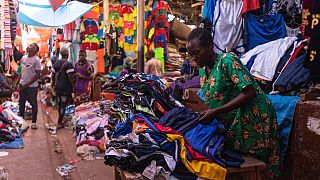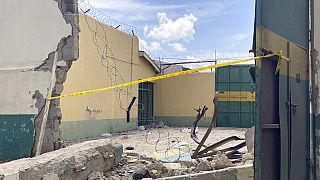Nigeria
**With rice consumption in Nigeria steadily rising, outgrowing local supply, there is now a supply gap of about 2 million metric tonnes annually, a new report says.
**
According to the AFEX Wet Season Crop Production Report for 2023, this has led to an over 37 per cent increase in the price of the commodity so far in 2023.
Impact on business
Some rice dealers in Nigeria say the price of the commodity fluctuates on a daily basis and is heavily impacting their business.
“I don’t have much rice because of the increase in price," says one rice dealer. "Sometimes I do get customers from various hotels but now I have lost most of my customers because of the increase."
Another dealer agrees, saying that the difference between now and this time last year is noticeable.
“Now there are no buyers, that is the problem we are having, customers are not coming like before," says Abdul Idris. "This time last year, the bag was N28, 000 but this year, it is N42, 000 but people are complaining of the money."
Buying less
Some customers say they are now buying smaller quantities of rice due to the price hike.
“It is really affecting me - and not just me," says Vera Abua, a customer. "Most Nigerians are complaining of the increase in the price of rice and now we don’t buy like we used to before."
AFEX's report says, “Rice consumption in Nigeria has been steadily increasing, aligning with the consistent growth of the rice market, nearly matching the annual population growth projection of 2.6 per cent at two per cent.”
The 37 per cent year-to-date price increase is driven by reduced production in 2022 due to the effects of flooding during the wet season of that year.
Self-sufficient
Richard Ogundele, an Agric Business expert,says that Nigeria is currently not self-sufficient in rice production compared to when it was in 2015.
“In 2016, Nigeria was meeting 84% of its local demand because we were able to provide about 5.4M metric tonnes," says Ogundele. "But from 2016 till now, a lot of things have happened in the country. One is the population growth, two is insecurity."
He also says that the price of input has increased by about 30-40% due to inflation affecting the ability of small holder farmers to produce.
“Our yields are low and we operate one circle. You can’t compare that with Vietnam and China that do two circles and much higher yields levels," he adds.
"Inputs are expensive and mechanisation is high out there, compared to Nigeria. So these challenges are still there, meaning, if we do not fix mechanisation, ensure that we make use of both seasons and find a way of subsidising some of these costs, we will keep struggling with the differentials."
West Africa's largest rice producer
Ogundele comments that it is ironic that Nigeria is the largest producer of rice in West Africa, yet still needs to import the commodity.
Globally, rice prices reached their highest point in nearly twelve years in 2023, primarily due to India’s ban on rice exports and the potential impact of El Nino on production in key regions.
These factors, along with rain-induced disruptions and variations in quality during Vietnam’s summer-autumn harvest have further contributed to the price surge.
However, Nigeria has spent over $15 billion in the past decade to meet its expanding rice consumption, despite its potential to be a net rice exporter, according to AFEX












01:44
Agriculture fair opens in drought-hit Morocco with focus on sustainability
11:08
Can Africa’s soil sustain food security? [Business Africa]
01:56
Ivory Coast: Women cooperative for vegetables transforming rural village
01:58
About 15 million Sudanese in need of urgent health assistance
01:47
Environmental Volunteering: Activists gather in Lagos ahead of World Earth Day
00:39
Nigerian chess master plays for 60 hours in bid to set new world record